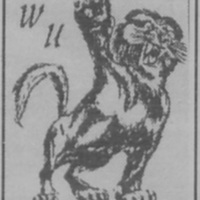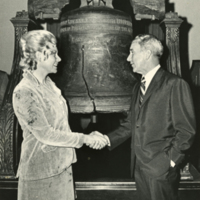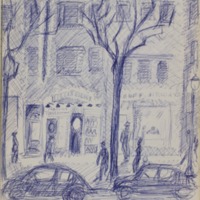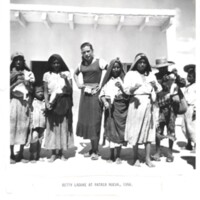Browse Exhibits (5 total)
Willamette Mascot

The question of many visitors to Willamette University is often "What on earth is a 'Bearcat'?" The truth is that there is not one single answer to that question, and it is also a question asked by the school itself over the years.
From Barney to Blitz, from cuddly to ferocious, the Willamette Bearcat has a long history. Explore the origins of Willamette's mascot and decide for yourself just what a 'Bearcat' actually is.
For more information about any of the images, just click them. From there you can also browse images with the same tags.
No Degree, No Problem: Norma Paulus

The Norma Paulus Collection was donated to the Willamette University Archives in 2010. This collection includes nearly 300 of her political photographs ranging from her time as legislator in the House of Representatives to the end of her political career as Superintendent of Public Instruction. Norma’s husband Bill and their two children, Fritz and Elizabeth are both pictured. The content of the pictures of Norma range from campaign for governor photos to pictures aboard an aircraft enroute to China.

Eunice Parsons & Process

Biography
Eunice Parsons was born in 1916 in Loma, Colorado but spent most of her young life in Chicago. When she was a young girl, she attended children’s classes at the University of Chicago where she learned an appreciation for art, as well as the skills that would allow her to pursue a career in the field later in life. After graduating high school, Parsons attended a few art classes from the University of Chicago. Soon after, Parsons married and moved to Portland along with her new husband. She spent the next two decades as a working mother. In the 1940s she began taking classes at the Portland Museum Art School. Shortly after, in 1957, she took a trip to the East Coast to acquaint and immerse herself in the culture of modern art. Parsons took a sketchbook where she made exhaustive notes and depicted many landscapes. This notebook showcases her earliest inclinations in playing with color, line, and shading, all developing into a unique and distinctive style. After returning from New York, Parsons continued her career as an artist and eventually began teaching at the Portland Museum Art School. While teaching, she became known as a blunt but brilliant instructor who encouraged her students to take their art seriously. She would also lead numerous student trips to Europe and the birthplaces of western art such as Italy, France, and Germany. In 2006 Parsons, along with others, was instrumental in opening the 12x16 Gallery in Portland. In 2017 she continues to be an influential and prolific artist at the age of 100.
Sketchbooks as a Medium
The sketchbook is situated as a place of safe practice and experimentation. It shows what the artist is looking to do removed from the constraints of more public work. The private nature allows the artist extensive freedom to express and explore forms that might otherwise be neglected. Because of these conditions the works that are found in a sketchbook reveal the inner workings of an artist's mind, showing more transparently what the artist is attempting to create, while also giving a sense of why they might be making those choices. The sketchbook is similar to a diary in this way, the attempts at creation are shown in their most raw state, and it is for this reason that they can be used to understand the process that is so key to creating more widely known works.
The Exhibition
Though Eunice Parsons is most widely known for her collages, which she began developing in the late 1960s, this exhibit aims to uncover the precursors that lead to the development of her more popular style through the lens of her personal sketchbooks. It is through investigating her interactions with process in her early career that the root of her collages can be understood. The culmination of several tendencies over the course of these three sketchbooks is the main subject of scrutiny. By examining the expressive qualities of Parsons' work through her usage of line, color, and shading that the ideology of her later collages can be understood. Through viewing selected images as examples of these trends, Parsons' stylistic development is illustrated along with commentary explaining the specific importance of the image.
Chuck Williams
This page is a work in progress.
Black and White Photos by Betty LaDuke

Despite the great volume and span of her works, it is unlikely to hear of Betty LaDuke outside of Oregon. Betty LaDuke is a world famous artist who has spent six decades of her life traveling the globe. She has spent time in Africa, Asia, and Latin America. This globe trotting lifestyle is the main focus in her life. By documenting the local cultures and experiences of the people in those regions it inspired her to create beautiful artworks that she has displayed in art galleries and exhibits around the country. These works include paintings, sketches, wall art, sculptures, and wood carvings. However not all of her art pieces have always been on display, LaDuke's personal sketches and photographs have primarily been kept in archives and personal collections like the ones here at Willamette. I myself had the privilege to view some of these pieces that can be found in the donated collection of LaDuke's housed here at Willamette. Of the many items in Laduke's collection here at Willamette I found myself drawn to one of LaDuke's earliest collections, her photos and sketches of her first trip to live with the Otomi Indians, one of the native peoples of Mexico.
The photos that Betty LaDuke took can only be described as hauntingly beautiful. The collection of black and white photographs taken by LaDuke of the native Otomi Indians in 1955, during the 3 year period that she stayed in Mexico. While in Mexico for University she quickly undertook a position in a local town as a visiting artist and worked with local town leaders to create murals for the area. To gain inspiration for these murals and her art pieces LaDuke spent a great amount of time living in the town and photographing its inhabitants. These photos provide us with excellent insight into the mind of LaDuke. It shows us not only what she saw, but what she chose to look at.